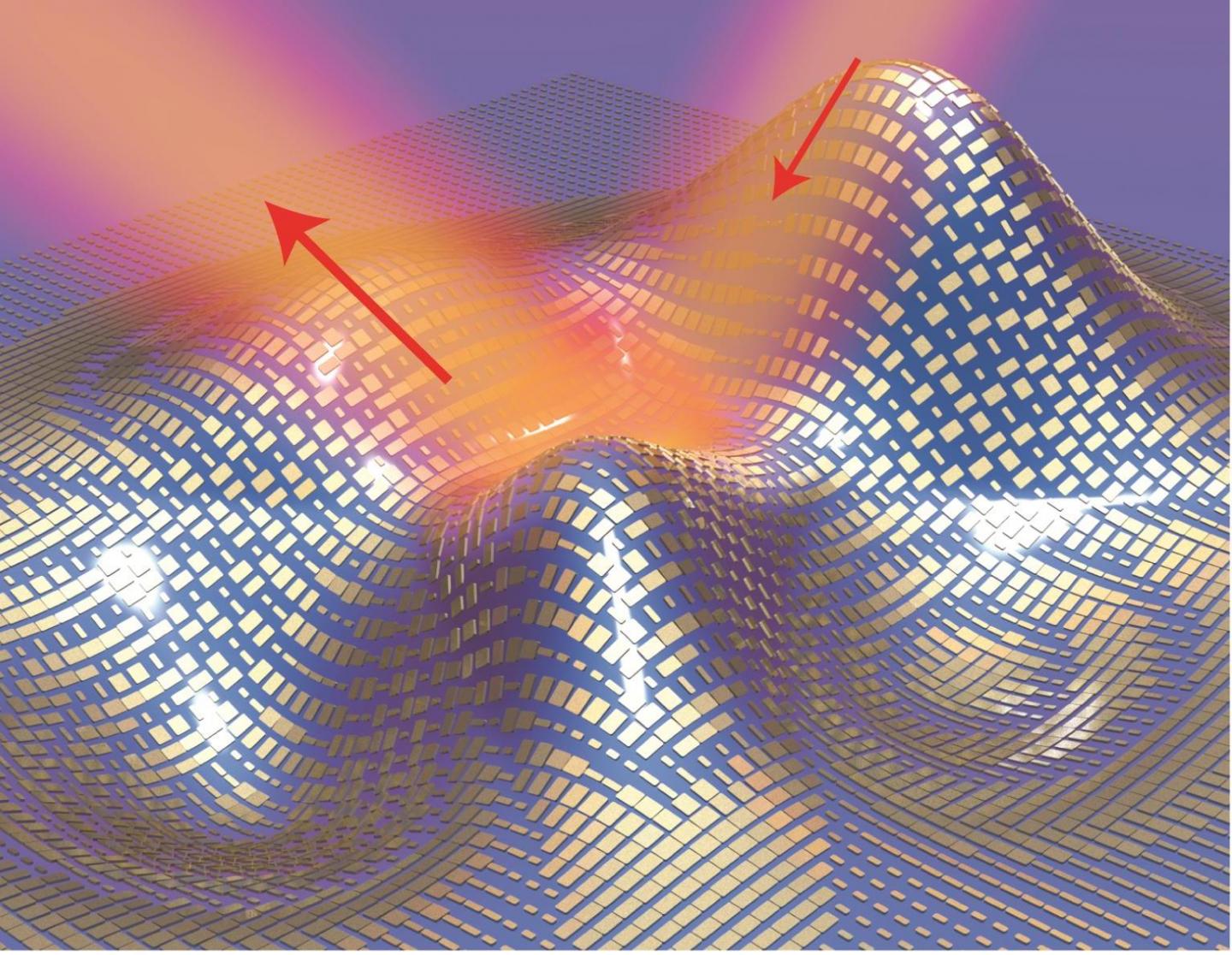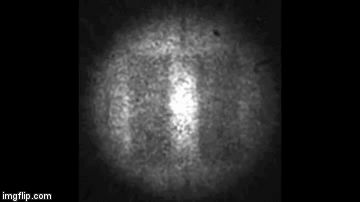How to make 3-D objects totally disappear
September 28, 2015

This image shows a 3-D illustration of a metasurface skin cloak made from an ultrathin layer of nanoantennas (gold blocks) covering an arbitrarily shaped object. When activated, light reflects off the cloak (red arrows) as if it were reflecting off a flat mirror. (credit: Image courtesy of Xiang Zhang group, Berkeley Lab/UC Berkeley)
An ultra-thin invisibility “skin” cloak that can conform to the shape of an object and conceal it from detection with visible light has been developed by scientists at Lawrence Berkeley National Laboratory (Berkeley Lab) and the University of California (UC) Berkeley.
Working with blocks of gold nanoantennas, the Berkeley researchers created a “skin cloak” just 80 nanometers in thickness that was wrapped around a three-dimensional object about the size of a few biological cells and shaped with multiple bumps and dents. The surface of the skin cloak was meta-engineered to reflect light waves, making the object invisible to optical detection when the cloak is activated.
“This is the first time a 3D object of arbitrary shape has been cloaked from visible light,” said Xiang Zhang, director of Berkeley Lab’s Materials Sciences Division. “Our ultra-thin cloak now looks like a coat. It is easy to design and implement, and is potentially scalable for hiding macroscopic objects.”
Zhang, who holds the Ernest S. Kuh Endowed Chair at UC Berkeley and is a member of the Kavli Energy NanoSciences Institute at Berkeley (Kavli ENSI), is the corresponding author of a paper describing this research in the journal Science.

Click to see an animation of an invisibility cloak that makes a 3-D object disappear (credit: Zhang group)
It is the scattering of light from its interaction with matter that enables us to detect and observe objects. The rules that govern these interactions in natural materials can be circumvented in metamaterials, whose optical properties arise from their physical structure rather than their chemical composition.
For the past ten years, Zhang and his research group have been pushing the boundaries of how light interacts with metamaterials, managing to curve the path of light or bend it backwards, phenomena not seen in natural materials, and to render objects optically undetectable. In the past, their metamaterial-based optical carpet cloaks were bulky and hard to scale up, and entailed a phase difference between the cloaked region and the surrounding background that made the cloak itself detectable, though what it concealed was not.
Now you see it, now you don’t
In the new study, the researchers used red light to illuminate an arbitrarily shaped 3-D sample object about 1,300 square micrometers in area and wrapped in the gold nanoantenna skin cloak. The light reflected off the surface of the skin cloak was identical to light reflected off a flat mirror, making the object underneath it invisible even by phase-sensitive detection. The cloak can be turned “on” or “off” simply by switching the polarization of the nanoantennas.
“A phase shift provided by each individual nanoantenna fully restores both the wavefront and the phase of the scattered light so that the object remains perfectly hidden,” says co-lead author Zi Jing Wong, also a member of Zhang’s research group.
According the researchers. the ability to manipulate the interactions between light and metamaterials offers future prospects for technologies such as high-resolution optical microscopes and superfast optical computers, and for hiding the detailed layout of microelectronic components or for security encryption purposes.
At the macroscale, among other applications, invisibility cloaks could prove useful for 3D displays, they add.
Abstract of An ultrathin invisibility skin cloak for visible light
Metamaterial-based optical cloaks have thus far used volumetric distribution of the material properties to gradually bend light and thereby obscure the cloaked region. Hence, they are bulky and hard to scale up and, more critically, typical carpet cloaks introduce unnecessary phase shifts in the reflected light, making the cloaks detectable. Here, we demonstrate experimentally an ultrathin invisibility skin cloak wrapped over an object. This skin cloak conceals a three-dimensional arbitrarily shaped object by complete restoration of the phase of the reflected light at 730-nanometer wavelength. The skin cloak comprises a metasurface with distributed phase shifts rerouting light and rendering the object invisible. In contrast to bulky cloaks with volumetric index variation, our device is only 80 nanometer (about one-ninth of the wavelength) thick and potentially scalable for hiding macroscopic objects.